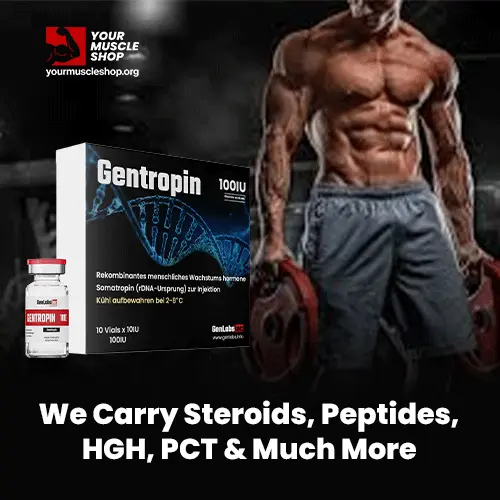Muscle Insider
New member
Nasal peptide sprays! A remarkable fusion of cutting-edge technology and the intricate complexities of the human body.
In this article, we delve into the world of peptide nasal sprays, exploring their role in overall health and how they have the potential to reshape the future of healthcare.
By offering a less invasive pathway of dosing, these could be the next step in peptide therapy – but are they safe, effective, or even worth it?
Key Takeaways
[*]Peptide nasal sprays were specifically developed to be used in such a manner.
[*]Peptide nasal sprays have several advantages, such as decreasing the risk of injection site infections.
[*]Peptide nasal sprays do have disadvantages, such as dosing being hard to determine.
[/list]
/wp-content/uploads/2023/08/Muscle-and-brawn-02-2.svg
What Are Peptide Nasal Sprays?
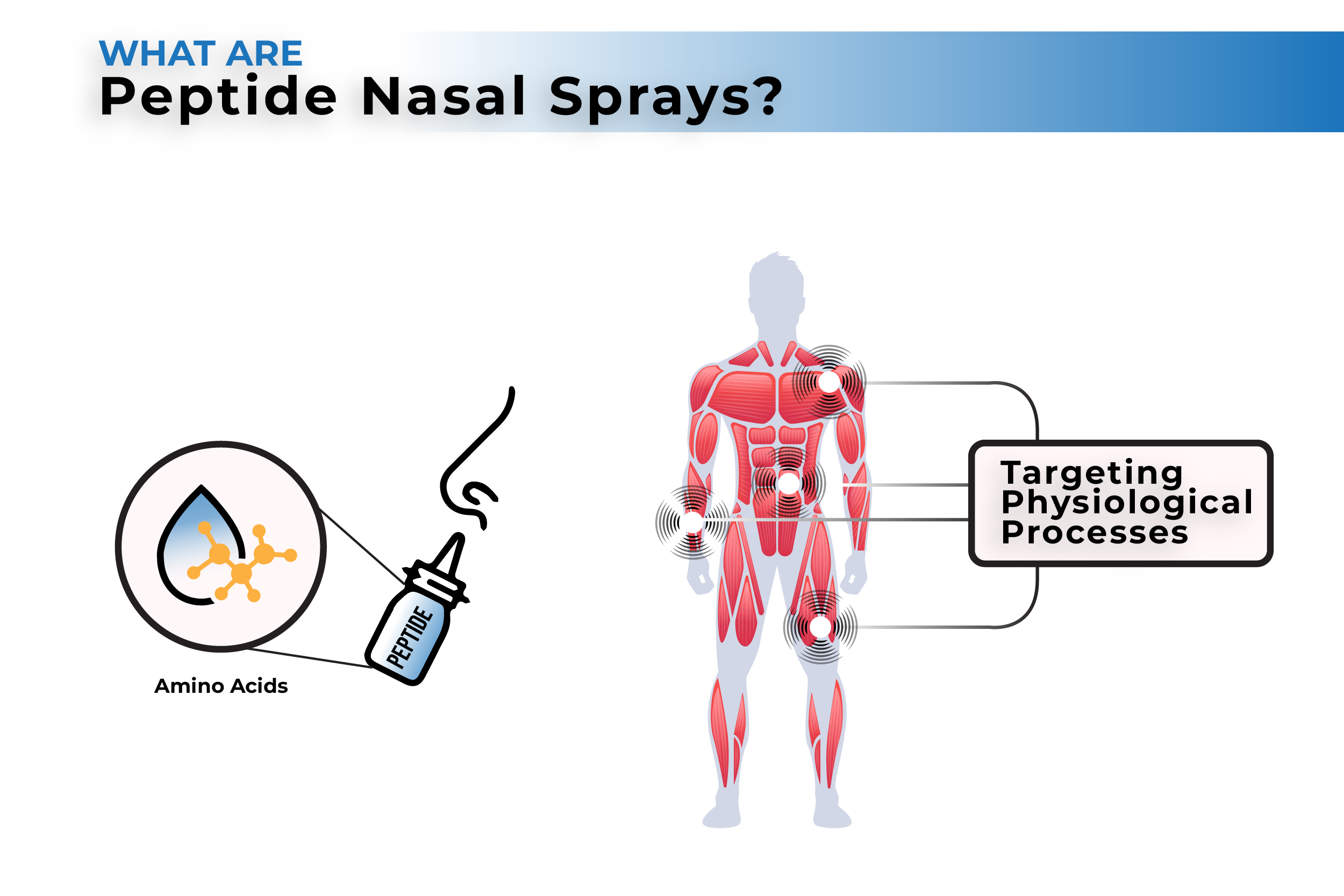
First, we need to make sure that we all understand what peptides are.
Peptide therapy is a medical approach that involves the targeted use of peptides to modulate physiological processes in the human body.
Peptides are short chains of amino acids, which are the building blocks of proteins.
They play a critical role in numerous biological functions, acting as signaling molecules and regulators of various cellular activities.
Peptides are usually injected into the fat of the human body, sometimes the muscle.
However, due to the risk of infections, companies have developed less invasive methods – such as nasal sprays.
Medical nasal sprays operate through intricate biochemical and physiological mechanisms to provide targeted therapeutic effects within the nasal and respiratory passages.
Nasal sprays are administered intranasally, typically as a fine mist or aerosol through a pressurized container or pump. Thus, less risk of infection!
The nasal mucosa is rich in blood vessels and capillaries, providing a large surface area for absorption.
The active ingredients in the spray are absorbed through the mucosal membrane into the bloodstream.
There are some interesting studies to look at when considering the implications of peptides in this realm [1].
Various clinics and resellers have begun using nasal peptides as an alternative to injectable versions and the results from people are rather good, people like ‘em.
List of Peptide Nasal Sprays
There are only certain peptides that are currently available in nasal form, including:
AOD 9604
The AOD9604 peptide, derived from hGH, effectively regulates fat metabolism by targeting areas with excess fat deposition.
It achieves this by enhancing fat breakdown (lipolysis) and suppressing fat synthesis (lipogenesis).
Unlike hGH, AOD9604 doesn’t impact insulin levels, reducing the risk of diabetes.
Additionally, it binds to unique receptors to stimulate fat breakdown and influences the release of fat metabolism-related hormones from the pituitary gland.
ADO 9604 SummaryAOD 9604
Losing excessive body weight and getting rid of obesity has just become much easier with the introduction of AOD9604 in the market.
AOD9604 is a synthetic fragment of the human growth hormone (HGH) C-terminus (176-191). This hexadecapeptide has shown remarkable effects on fat metabolism by upregulating lipolysis and inhibiting lipogenesis.
AOD9604 targets fat-rich areas and promotes fat breakdown without disturbing the overall metabolic profile.
AOD9604 was well advocated as an anti-obesity medication in the past as it cuts down fat deposition. Perhaps this was confirmed in one of the clinical trials taking place in Australia, where nearly 300 obese individuals experienced weight loss.
Besides, AOD9604 doesn’t affect IGF-1 and insulin levels, thus ensuring minimal risk of developing glucose intolerance and diabetes mellitus. With AOD9604, you don’t have to worry about hypercholesterolemia as well!
The good news is that AOD9604 is an FDA-approved drug as an anti-obesity drug, so you don’t have to worry about adverse effects at all. All you can expect is mild headaches, indigestion, nausea, swelling, etc.
AOD9604 can really be your go-to therapy for weight loss but make sure to use it at the proper dosages, or else a disturbed metabolic profile awaits you!
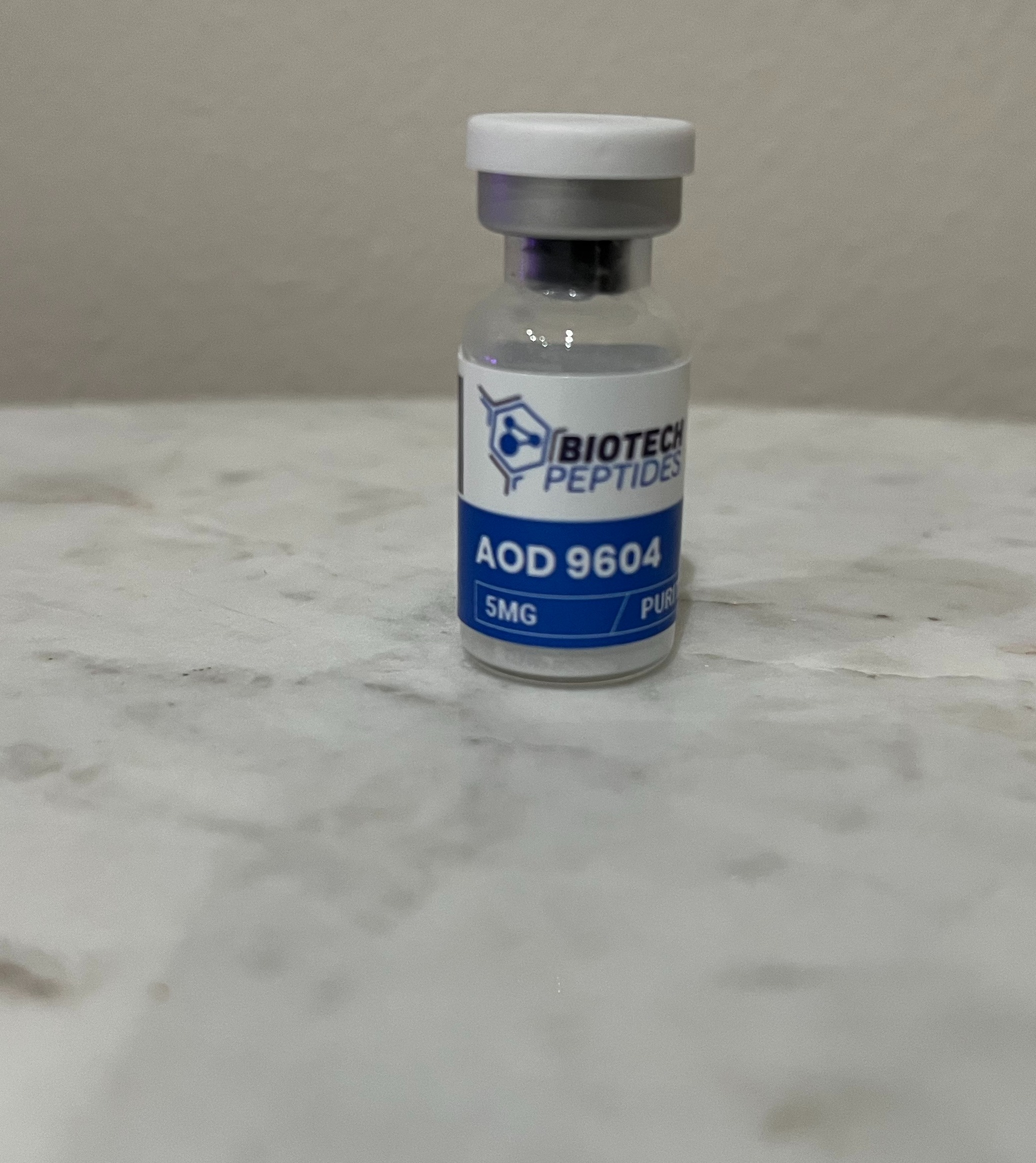 FIND BEST PRICE[/i]Features
FIND BEST PRICE[/i]Features
 Forms: Powders, Spray
Forms: Powders, Spray
 Cycle Length: 20 Days
Cycle Length: 20 Days
 Dosage: 300 mcg/day
Dosage: 300 mcg/day
Benefits: Weightless, Prevents Hypercholesterolemia
 Cost: $79.99
Cost: $79.99
 Side Effects: Headache, Indigestion
Side Effects: Headache, Indigestion
Stacks: AOD 9604/Semaglutide
[/i]
BPC 157
BPC-157 exerts its therapeutic effects through various mechanisms.
These include promoting angiogenesis (new blood vessel formation) and blocking inhibitory growth factors.
Furthermore, it also enhances tendon cell receptors for accelerated healing, optimizing fibroblast activity for collagen synthesis, influencing neurotransmitters to reduce symptoms of depression and anxiety, and stimulating nitric oxide production to lower blood pressure and manage conditions like hyperkalemia.
BPC 157 SummaryBPC-157
BPC-157, or pentadecapeptide, is categorized as a body protection compound. It is composed of 15 amino acids in a very particular sequence that doesn’t exist naturally.
It is artificially synthesized in laboratories using the partial sequence of the body-protecting compounds isolated from gastric juices. Hence, it is one of the derivatives of the peptide found in human gastric juices.
The therapeutic effects of BPC-157 are exerted through multiple courses of action. One of the most common ways that BPC-157 acts as a therapeutic agent is by carrying out angiogenesis, which is the formation of new blood vessels.
It does this by activating a protein called the “vascular endothelial growth factor” which initiates the formation of new blood vessels. This ensues in the organization of a healthy vascular network which gives BPC-157 its key regenerative and healing properties.
Another mechanism of action of BPC-157 is blocking the inhibitory growth factor called 4-hydroxynonenal, which is a negative modulator of growth. This allows the peptide to carry out effective healing of wounds, especially surrounding tendons.
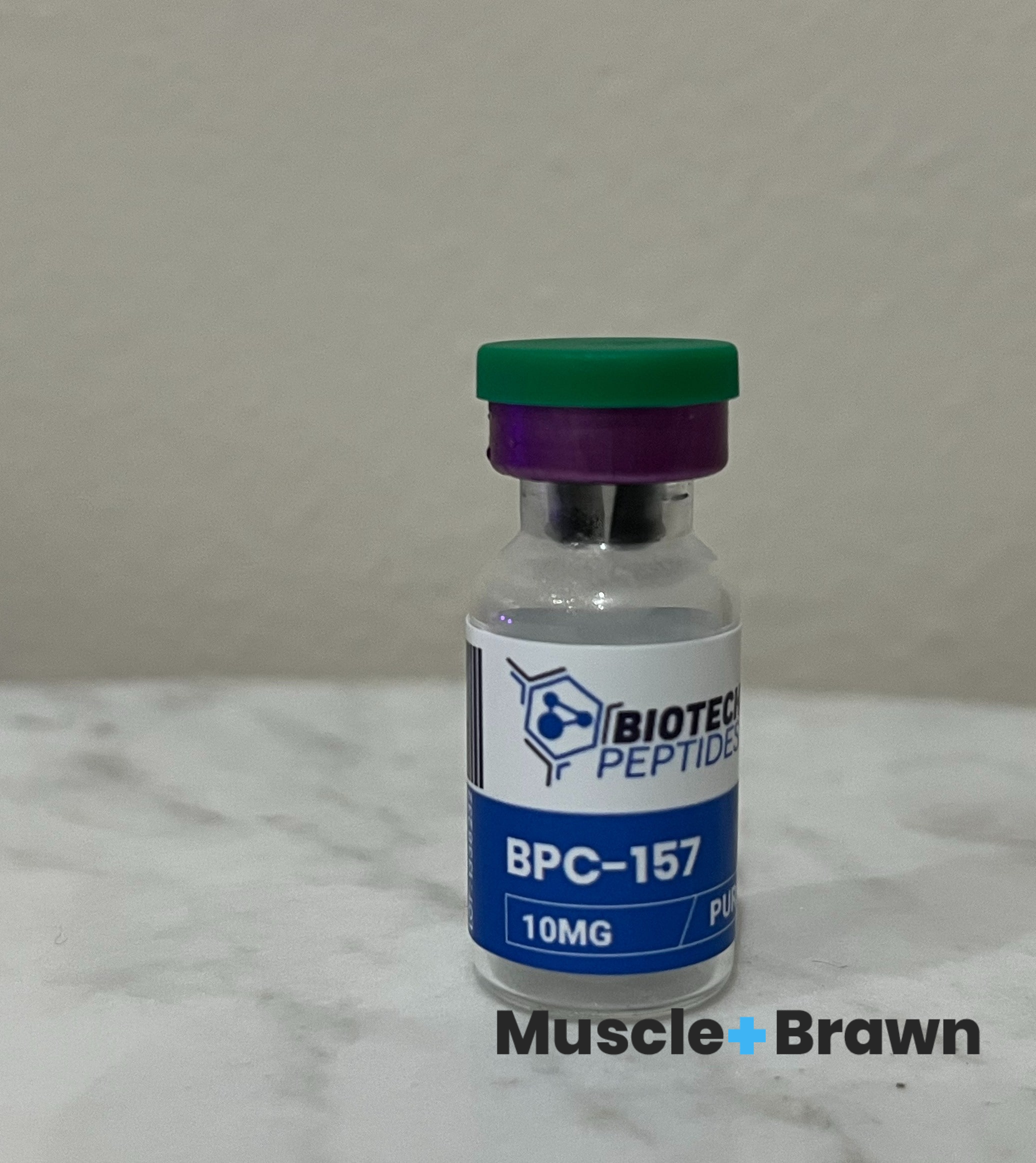 FIND BEST PRICE[/i]BPC-157 Overview
FIND BEST PRICE[/i]BPC-157 Overview
 Top Benefits: Recovery from injury
Top Benefits: Recovery from injury
 Form: Injectable liquid, Nasal Spray
Form: Injectable liquid, Nasal Spray
 Max Time Used: 14 weeks
Max Time Used: 14 weeks
 Average Cost: $51.99
Average Cost: $51.99
 Side Effects: Abdominal pain
Side Effects: Abdominal pain
 Dangers: Not really
Dangers: Not really
 Best Peptide Stack: TB 500 / HGH / IGF-1
Best Peptide Stack: TB 500 / HGH / IGF-1
 Go to the Full review
Go to the Full review
[/i]
TB500
TB500, or Thymosin Beta-4, is a synthetic peptide known for its exceptional healing properties.
It works by promoting cell migration, proliferation, and differentiation, aiding tissue repair.
TB500 has applications in wound healing, muscle repair, cardiovascular regeneration, and managing inflammation and joint injuries.
While its potential in various therapies is promising, ongoing research is needed to confirm its safety and effectiveness in clinical use.
TB500 SummaryTB-500
Thymosin beta-4 is a small peptide with G actin-sequestering action. It is associated with the induction of angiogenesis and accelerated wound healing (10).
TB-500 is a synthetic version of the naturally occurring peptide LKKTETQ. The peptide segment (17)LKKTETQ(23) is the active site within the protein thymosin ?(4) responsible for actin binding, cell migration and wound healing
Muscle fibers are made up of actin and myosin, which are contractile filaments. These filaments allow our muscles to contract and relax for mobility and carry out efficient metabolism and cell signaling.
TB-500 increases our body’s response to actin by increased reception of the protein by the peptide segment (17)LKKTETQ(23). This upregulation promotes increased cell growth, healthy cell proliferation, healing effects, and cell migration, particularly keratinocytes and endothelial cells.
TB-500 promotes angiogenesis which is the formation of new blood vessels. It builds up new blood vessel pathways for efficient blood supply to the wounds for increased healing. It also augments beneficial inflammation at the site of injuries.
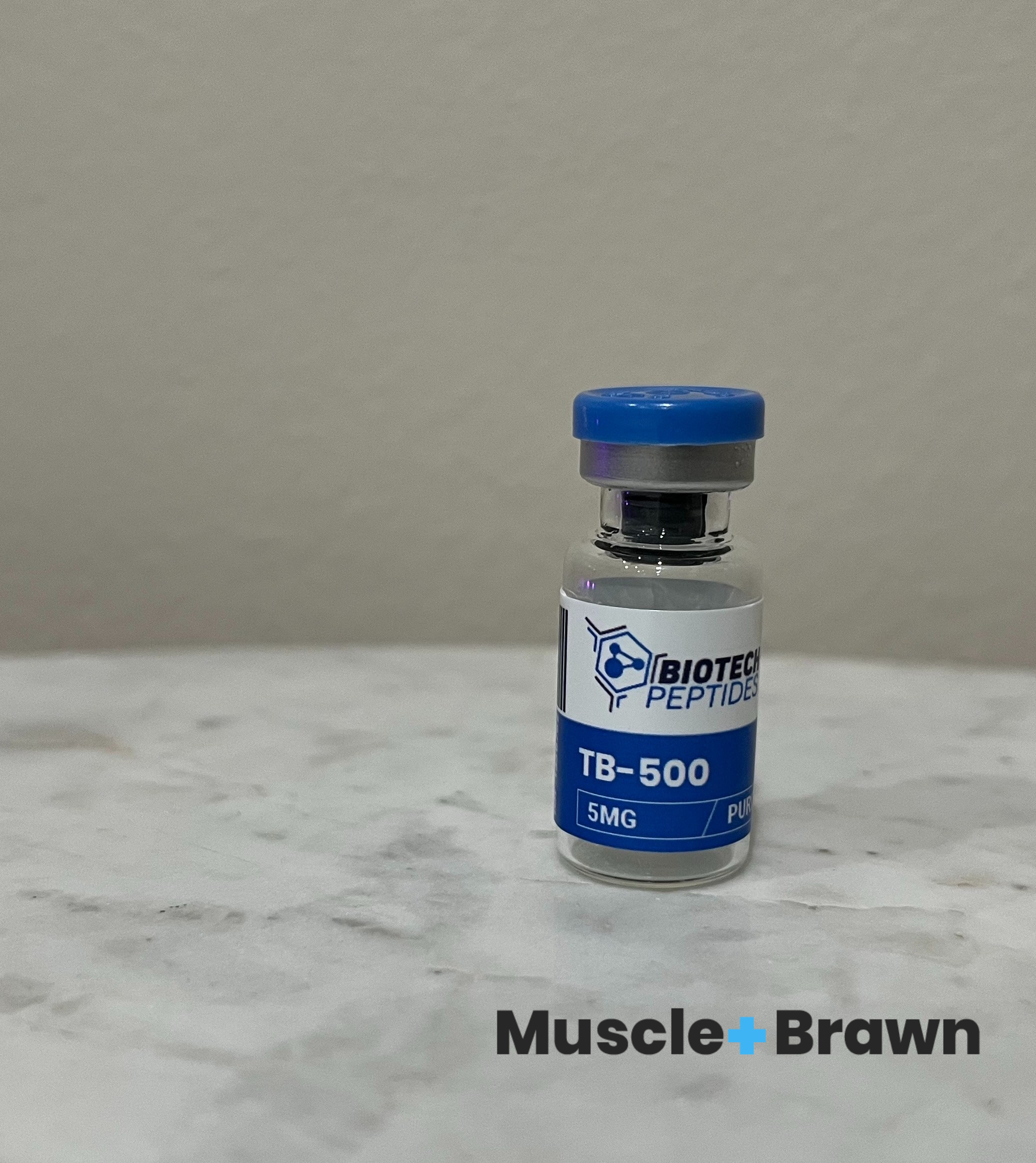 FIND BEST PRICE[/i]TB-500 Overview
FIND BEST PRICE[/i]TB-500 Overview
 Top Benefit: Rapid recovery from injuries
Top Benefit: Rapid recovery from injuries
 Form: Injectable liquid, Capsules, Transdermal patches
Form: Injectable liquid, Capsules, Transdermal patches
 Typical Dosage: 7.66 mg/week
Typical Dosage: 7.66 mg/week
 Typical cycle duration: 14 weeks
Typical cycle duration: 14 weeks
 Average Cost: $69.99
Average Cost: $69.99
 Availability: Easily available
Availability: Easily available
 Side Effects and Dangers: Headaches and stomach discomfort
Side Effects and Dangers: Headaches and stomach discomfort
 Best Peptide Stack: BPC-157 / TB-500
Best Peptide Stack: BPC-157 / TB-500
 Go to the Full review
Go to the Full review
[/i]
CJC-1295
CJC-1295 is a potent growth hormone-releasing hormone analog consisting of 30 amino acids.
It was developed by ConjuChem Technologies, initially as an improved version of Sermorelin Acetate.
It comes in two forms, with or without Drug Affinity Complex (DAC), with the DAC version having better bioavailability and a longer half-life due to its binding to blood proteins.
CJC 1295 For SaleCJC-1295 For Sale
CJC 1295 is a synthetic peptide known for its ability to stimulate the secretion of growth hormone (GH) in the body, which it achieves by acting as a mimic of growth hormone-releasing hormone (GHRH), a natural hormone produced in the hypothalamus.
CJC 1295 consists of 29 amino acids and is utilized to enhance GH production in a controlled and sustained manner.
By binding to and activating the GHRH receptors in the pituitary gland, CJC 1295 prompts an increase in the release of GH into the bloodstream, playing a crucial role in various physiological processes, including muscle growth, fat metabolism, tissue repair, and overall health and vitality.
CJC 1295’s capacity to elevate GH levels makes it a popular choice among athletes, bodybuilders, and individuals seeking to improve their physical performance and appearance.
It can promote muscle development, reduce body fat, and accelerate recovery from injuries. Additionally, CJC 1295 has been explored for its potential anti-aging effects and its ability to enhance overall well-being.
It can be a valuable tool for individuals looking to optimize their hormonal balance and achieve specific health and fitness goals.
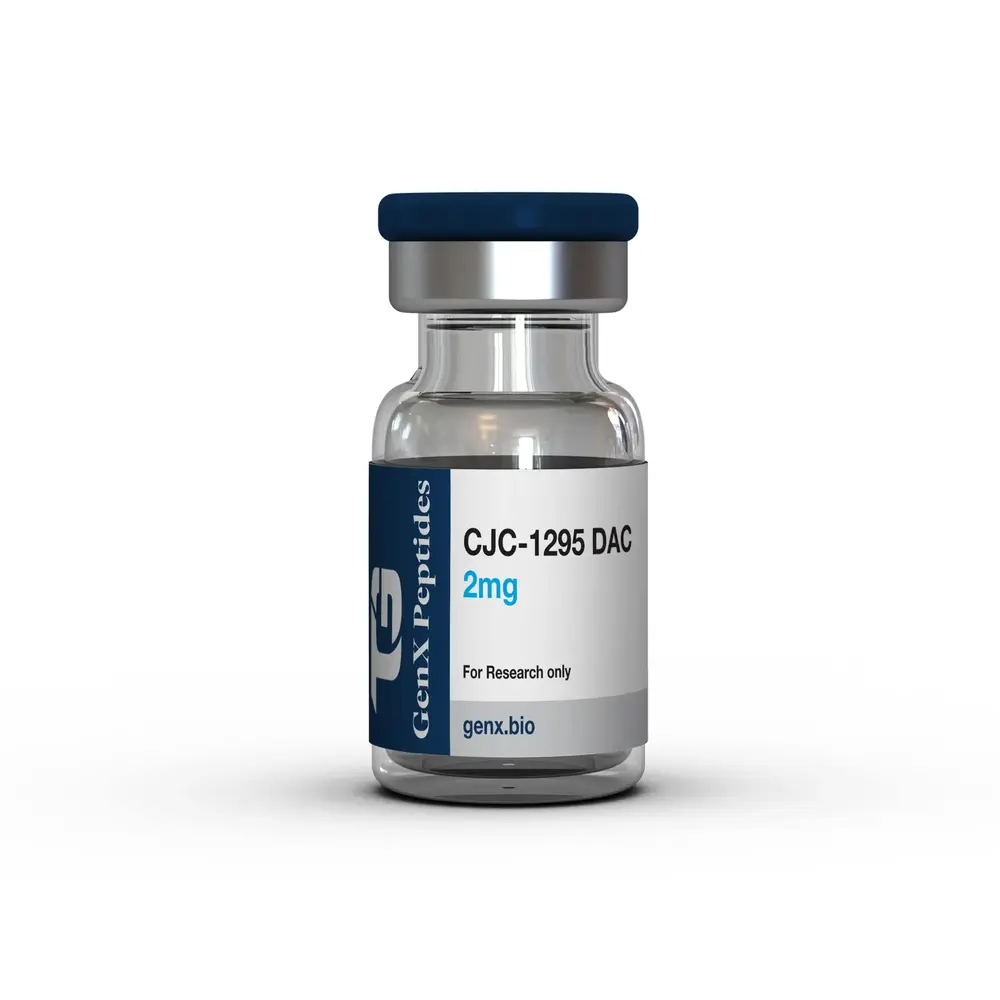 FIND BEST PRICE[/i]CJC-1295 Overview
FIND BEST PRICE[/i]CJC-1295 Overview
 Top Benefits: Skin elasticity, muscle growth, fat loss, and improved recovery
Top Benefits: Skin elasticity, muscle growth, fat loss, and improved recovery
 Form: Lyophilized (freeze-dried) powder form, reconstituted with bacteriostatic water before injection
Form: Lyophilized (freeze-dried) powder form, reconstituted with bacteriostatic water before injection
 Max Time Used: 8 to 12 weeks
Max Time Used: 8 to 12 weeks
 Average Cost: $52
Average Cost: $52
 Side Effects: May include injection site reactions, water retention, and potential impact on insulin sensitivity.
Side Effects: May include injection site reactions, water retention, and potential impact on insulin sensitivity.
 Dangers: Overuse or misuse of CJC 1295 may lead to unwanted side effects.
Dangers: Overuse or misuse of CJC 1295 may lead to unwanted side effects.
 Best Peptide Stack: Ipamorelin/GHRP-6/TB-500
Best Peptide Stack: Ipamorelin/GHRP-6/TB-500
? Men/Women: Men and women
 Go to the Full review
Go to the Full review
[/i]
DSIP
Delta sleep-inducing peptide, DSIP, is a naturally occurring neuropeptide initially extracted from rabbit brain venous blood during slow-wave sleep in the 1970s-1980s.
It’s synthesized in the rabbit’s hypothalamus and targets various areas in the central nervous system.
DSIP, consisting of 9 amino acids (Trp-Ala-Gly-Gly-Asp-Ala-Ser-Gly-Glu), concentrates in brain regions like the thalamus, cerebral cortex, and cerebellum.
It effectively crosses the blood-brain barrier to initiate its sleep-inducing mechanism.
Epithalon
Epithalon, also known as Epithalon peptide, is a synthetic tetrapeptide composed of 4 amino acids: Ala-Glu-Asp-Gly, with the molecular formula C14H22N4O9.
It is derived from Epithalamin, a natural polypeptide released from the pineal gland, often referred to as the “third eye.”
Epitalon is a synthetic telomerase activator enzyme that upregulates the synthesis of telomerase enzyme by the pineal gland.
Thus, telomeres at the end of chromosomes are renewed and more telomeres are available at the tips of DNA strands even after a cell divides repeatedly.
Copper Peptides
GHK-Cu peptide primarily focuses on skin protection and regeneration, with additional benefits in lung injuries and wound healing.
It stimulates collagen and glycosaminoglycan synthesis, essential for connective tissue, and tightening sagging skin.
GHK-Cu also regulates metalloproteinases, preventing the accumulation of damaged proteins that can affect facial skin’s appearance.
GHRP 2
GHRP-2, a growth hormone secretagogue (GHS), binds to the GHS-R receptor, prompting increased growth hormone (GH) secretion from the anterior pituitary gland.
It achieves this by suppressing somatostatin (GHIH) release, disrupting the negative feedback system, and elevating GH levels.
GHRP-2 acts as an agonist for ghrelin, boosting appetite and hunger while enhancing GH release.
Additionally, GHRP-2 has a modest impact on raising serum hormone levels like prolactin, ACTH, and cortisol.
Hexarelin
Hexarelin’s primary function is to induce growth hormone release from the anterior pituitary gland through various mechanisms.
It mimics ghrelin, a stomach-synthesized hormone, binding to the growth hormone secretagogue receptor (GHS-R1a) in the hippocampus, activating pathways for GH release, cardiomyocyte protection, weight regulation, and musculoskeletal development.
HGH Fragment
HGH-FRAG is a truncated version of Human Growth Hormone, comprising the final 16 amino acids of the original 191-long sequence, with a chemical formula of C39H60N8O13.
However, it operates differently from HGH. Unlike full-length GH, HGH-FRAG cannot bind to Growth Hormone Receptors (GHR) due to its incomplete amino acid sequence.
Consequently, it cannot trigger IGF-1 formation or perform anabolic functions like GH.
HGH-FRAG 176-191 primarily retains the lipolytic properties of GH, making it a popular choice for lipid metabolism-related functions.
Ipamorelin
Ghrelin, a naturally produced hormone in the gastrointestinal tract, binds to the growth hormone secretagogue receptor (GHS-R1a).
GHSR1a is highly expressed in the hypothalamus and extrahypothalamic regions, as well as in peripheral tissues like adipocytes, cardiomyocytes, and osteoblasts, impacting various functions including glucose-insulin balance, gastrointestinal motility, cardiovascular health, inflammation, and tissue growth and repair.
Melanotan
Melanotan I, or Afamelanotide, is a 13-amino acid peptide sold as Scenesse.
It mimics the endogenous hormone alpha-melanocyte stimulating hormone (?-MSH), initially developed for tanning but has shown effects in preventing phototoxicity and affecting the central nervous system.
In contrast, Melanotan II is a 7-amino acid synthetic peptide with broad effects, primarily targeting melanocortin receptors.
It promotes skin tanning, increases energy, and enhances sexual performance.
MOTS-C
Mots-c is a 16-amino acid peptide derived from the mitochondrial genome.
It has been studied for its therapeutic potential, particularly in regulating metabolic pathways related to energy production, weight management, exercise, longevity, and glucose metabolism.
Thanks to its systemic effects, mots-c holds promise as a therapeutic peptide, including potential applications for recreational purposes.
Are Peptide Nasal Sprays as Effective?
The next logical question you might have is whether or not these sprays are effective or not – well, let’s look at the research:
They found a distinct connection between your nose structure and how much of the medication you actually absorb – meaning even though you might buy a good quality peptide, it doesn’t mean you get it all
Overall, these peptides only have one benefit over their counterparts – they don’t need to be injected, meaning there is a far lower risk of infections and other such complications.
Are Peptide Nasal Sprays Safe?
There are no human studies looking at the safety of anti-aging peptides and their nasal application, unfortunately.
However, there are no horror stories online that we know of.
Conclusion
In the realm of peptide therapy, the advent of nasal peptide sprays represents an intriguing fusion of modern technology and human biology.
These sprays offer a less invasive means of administration, potentially reshaping the future of healthcare.
While they bring advantages such as reduced risk of infection, there are questions regarding their effectiveness and safety.
FAQs
Are Nasal Peptides Effective?
Yes, nasal peptides can be effective for various purposes, including drug delivery and therapeutic applications. The nasal route allows for rapid absorption, making it a convenient option for certain peptide formulations.
What is The Best Nasal Peptide Spray?
Determining the best nasal peptide spray depends on individual needs. Consult with a healthcare professional to find a suitable option tailored to your specific health goals and conditions.
What Peptides Help With Seizures?
Certain peptides, such as neuropeptide Y (NPY), show potential in modulating neuronal activity and may help with seizures. However, it’s crucial to consult a medical professional for personalized advice and treatment.
What is the Best Peptide for Brain Repair?
Peptides like brain-derived neurotrophic factor (BDNF) are known for their neuroprotective and regenerative properties, making them potentially beneficial for brain repair.
Citations:
[*]Alabsi W, Eedara BB, Encinas-Basurto D, Polt R, Mansour HM. Nose-to-Brain Delivery of Therapeutic Peptides as Nasal Aerosols. Pharmaceutics. 2022 Sep 5;14(9):1870. doi: 10.3390/pharmaceutics14091870. PMID: 36145618; PMCID: PMC9502087.
[*]Fransén, Nelly (2008). Studies on a Novel Powder Formulation for Nasal Drug Delivery (PhD dissertation). Uppsala University. ISBN 978-91-554-7288-7.
[*]Shang Y, Inthavong K, Qiu D, Singh N, He F, Tu J. Prediction of nasal spray drug absorption influenced by mucociliary clearance. PLoS One. 2021 Jan 28;16(1):e0246007. doi: 10.1371/journal.pone.0246007. PMID: 33507973; PMCID: PMC7842989.
Click here to view the article.
In this article, we delve into the world of peptide nasal sprays, exploring their role in overall health and how they have the potential to reshape the future of healthcare.
By offering a less invasive pathway of dosing, these could be the next step in peptide therapy – but are they safe, effective, or even worth it?
Key Takeaways
[*]Peptide nasal sprays were specifically developed to be used in such a manner.
[*]Peptide nasal sprays have several advantages, such as decreasing the risk of injection site infections.
[*]Peptide nasal sprays do have disadvantages, such as dosing being hard to determine.
[/list]
/wp-content/uploads/2023/08/Muscle-and-brawn-02-2.svg
What Are Peptide Nasal Sprays?

First, we need to make sure that we all understand what peptides are.
Peptide therapy is a medical approach that involves the targeted use of peptides to modulate physiological processes in the human body.
Peptides are short chains of amino acids, which are the building blocks of proteins.
They play a critical role in numerous biological functions, acting as signaling molecules and regulators of various cellular activities.
Peptides are usually injected into the fat of the human body, sometimes the muscle.
However, due to the risk of infections, companies have developed less invasive methods – such as nasal sprays.
Medical nasal sprays operate through intricate biochemical and physiological mechanisms to provide targeted therapeutic effects within the nasal and respiratory passages.
Nasal sprays are administered intranasally, typically as a fine mist or aerosol through a pressurized container or pump. Thus, less risk of infection!
The nasal mucosa is rich in blood vessels and capillaries, providing a large surface area for absorption.
The active ingredients in the spray are absorbed through the mucosal membrane into the bloodstream.
There are some interesting studies to look at when considering the implications of peptides in this realm [1].
Various clinics and resellers have begun using nasal peptides as an alternative to injectable versions and the results from people are rather good, people like ‘em.
List of Peptide Nasal Sprays
There are only certain peptides that are currently available in nasal form, including:
AOD 9604
The AOD9604 peptide, derived from hGH, effectively regulates fat metabolism by targeting areas with excess fat deposition.
It achieves this by enhancing fat breakdown (lipolysis) and suppressing fat synthesis (lipogenesis).
Unlike hGH, AOD9604 doesn’t impact insulin levels, reducing the risk of diabetes.
Additionally, it binds to unique receptors to stimulate fat breakdown and influences the release of fat metabolism-related hormones from the pituitary gland.
ADO 9604 SummaryAOD 9604
Losing excessive body weight and getting rid of obesity has just become much easier with the introduction of AOD9604 in the market.
AOD9604 is a synthetic fragment of the human growth hormone (HGH) C-terminus (176-191). This hexadecapeptide has shown remarkable effects on fat metabolism by upregulating lipolysis and inhibiting lipogenesis.
AOD9604 targets fat-rich areas and promotes fat breakdown without disturbing the overall metabolic profile.
AOD9604 was well advocated as an anti-obesity medication in the past as it cuts down fat deposition. Perhaps this was confirmed in one of the clinical trials taking place in Australia, where nearly 300 obese individuals experienced weight loss.
Besides, AOD9604 doesn’t affect IGF-1 and insulin levels, thus ensuring minimal risk of developing glucose intolerance and diabetes mellitus. With AOD9604, you don’t have to worry about hypercholesterolemia as well!
The good news is that AOD9604 is an FDA-approved drug as an anti-obesity drug, so you don’t have to worry about adverse effects at all. All you can expect is mild headaches, indigestion, nausea, swelling, etc.
AOD9604 can really be your go-to therapy for weight loss but make sure to use it at the proper dosages, or else a disturbed metabolic profile awaits you!




Benefits: Weightless, Prevents Hypercholesterolemia


Stacks: AOD 9604/Semaglutide
[/i]
- Marked fat loss
- It can help prevent cardiovascular and metabolic disorders away
- Pain, redness, and flushing of the face can be experienced after the injection
BPC 157
BPC-157 exerts its therapeutic effects through various mechanisms.
These include promoting angiogenesis (new blood vessel formation) and blocking inhibitory growth factors.
Furthermore, it also enhances tendon cell receptors for accelerated healing, optimizing fibroblast activity for collagen synthesis, influencing neurotransmitters to reduce symptoms of depression and anxiety, and stimulating nitric oxide production to lower blood pressure and manage conditions like hyperkalemia.
BPC 157 SummaryBPC-157
BPC-157, or pentadecapeptide, is categorized as a body protection compound. It is composed of 15 amino acids in a very particular sequence that doesn’t exist naturally.
It is artificially synthesized in laboratories using the partial sequence of the body-protecting compounds isolated from gastric juices. Hence, it is one of the derivatives of the peptide found in human gastric juices.
The therapeutic effects of BPC-157 are exerted through multiple courses of action. One of the most common ways that BPC-157 acts as a therapeutic agent is by carrying out angiogenesis, which is the formation of new blood vessels.
It does this by activating a protein called the “vascular endothelial growth factor” which initiates the formation of new blood vessels. This ensues in the organization of a healthy vascular network which gives BPC-157 its key regenerative and healing properties.
Another mechanism of action of BPC-157 is blocking the inhibitory growth factor called 4-hydroxynonenal, which is a negative modulator of growth. This allows the peptide to carry out effective healing of wounds, especially surrounding tendons.








 Go to the Full review
Go to the Full review [/i]
- Improved recovery from injuries
- Improved gastric function
- Injection site pain
- Abdominal pain
TB500
TB500, or Thymosin Beta-4, is a synthetic peptide known for its exceptional healing properties.
It works by promoting cell migration, proliferation, and differentiation, aiding tissue repair.
TB500 has applications in wound healing, muscle repair, cardiovascular regeneration, and managing inflammation and joint injuries.
While its potential in various therapies is promising, ongoing research is needed to confirm its safety and effectiveness in clinical use.
TB500 SummaryTB-500
Thymosin beta-4 is a small peptide with G actin-sequestering action. It is associated with the induction of angiogenesis and accelerated wound healing (10).
TB-500 is a synthetic version of the naturally occurring peptide LKKTETQ. The peptide segment (17)LKKTETQ(23) is the active site within the protein thymosin ?(4) responsible for actin binding, cell migration and wound healing
Muscle fibers are made up of actin and myosin, which are contractile filaments. These filaments allow our muscles to contract and relax for mobility and carry out efficient metabolism and cell signaling.
TB-500 increases our body’s response to actin by increased reception of the protein by the peptide segment (17)LKKTETQ(23). This upregulation promotes increased cell growth, healthy cell proliferation, healing effects, and cell migration, particularly keratinocytes and endothelial cells.
TB-500 promotes angiogenesis which is the formation of new blood vessels. It builds up new blood vessel pathways for efficient blood supply to the wounds for increased healing. It also augments beneficial inflammation at the site of injuries.









 Go to the Full review
Go to the Full review [/i]
- Rapid wound healing
- Heals ligament and joint injuries
- Helps build endurance
- Injection site pain
- Abdominal pain
- Headaches
CJC-1295
CJC-1295 is a potent growth hormone-releasing hormone analog consisting of 30 amino acids.
It was developed by ConjuChem Technologies, initially as an improved version of Sermorelin Acetate.
It comes in two forms, with or without Drug Affinity Complex (DAC), with the DAC version having better bioavailability and a longer half-life due to its binding to blood proteins.
CJC 1295 For SaleCJC-1295 For Sale
CJC 1295 is a synthetic peptide known for its ability to stimulate the secretion of growth hormone (GH) in the body, which it achieves by acting as a mimic of growth hormone-releasing hormone (GHRH), a natural hormone produced in the hypothalamus.
CJC 1295 consists of 29 amino acids and is utilized to enhance GH production in a controlled and sustained manner.
By binding to and activating the GHRH receptors in the pituitary gland, CJC 1295 prompts an increase in the release of GH into the bloodstream, playing a crucial role in various physiological processes, including muscle growth, fat metabolism, tissue repair, and overall health and vitality.
CJC 1295’s capacity to elevate GH levels makes it a popular choice among athletes, bodybuilders, and individuals seeking to improve their physical performance and appearance.
It can promote muscle development, reduce body fat, and accelerate recovery from injuries. Additionally, CJC 1295 has been explored for its potential anti-aging effects and its ability to enhance overall well-being.
It can be a valuable tool for individuals looking to optimize their hormonal balance and achieve specific health and fitness goals.








? Men/Women: Men and women
 Go to the Full review
Go to the Full review [/i]
- Potentially rapid recovery from injuries
- Potential for muscle growth
- Anti-aging Benefits
- Injection site pain
- Possibility of water retention
- Risk of altered blood sugar levels
DSIP
Delta sleep-inducing peptide, DSIP, is a naturally occurring neuropeptide initially extracted from rabbit brain venous blood during slow-wave sleep in the 1970s-1980s.
It’s synthesized in the rabbit’s hypothalamus and targets various areas in the central nervous system.
DSIP, consisting of 9 amino acids (Trp-Ala-Gly-Gly-Asp-Ala-Ser-Gly-Glu), concentrates in brain regions like the thalamus, cerebral cortex, and cerebellum.
It effectively crosses the blood-brain barrier to initiate its sleep-inducing mechanism.
Epithalon
Epithalon, also known as Epithalon peptide, is a synthetic tetrapeptide composed of 4 amino acids: Ala-Glu-Asp-Gly, with the molecular formula C14H22N4O9.
It is derived from Epithalamin, a natural polypeptide released from the pineal gland, often referred to as the “third eye.”
Epitalon is a synthetic telomerase activator enzyme that upregulates the synthesis of telomerase enzyme by the pineal gland.
Thus, telomeres at the end of chromosomes are renewed and more telomeres are available at the tips of DNA strands even after a cell divides repeatedly.
Copper Peptides
GHK-Cu peptide primarily focuses on skin protection and regeneration, with additional benefits in lung injuries and wound healing.
It stimulates collagen and glycosaminoglycan synthesis, essential for connective tissue, and tightening sagging skin.
GHK-Cu also regulates metalloproteinases, preventing the accumulation of damaged proteins that can affect facial skin’s appearance.
GHRP 2
GHRP-2, a growth hormone secretagogue (GHS), binds to the GHS-R receptor, prompting increased growth hormone (GH) secretion from the anterior pituitary gland.
It achieves this by suppressing somatostatin (GHIH) release, disrupting the negative feedback system, and elevating GH levels.
GHRP-2 acts as an agonist for ghrelin, boosting appetite and hunger while enhancing GH release.
Additionally, GHRP-2 has a modest impact on raising serum hormone levels like prolactin, ACTH, and cortisol.
Hexarelin
Hexarelin’s primary function is to induce growth hormone release from the anterior pituitary gland through various mechanisms.
It mimics ghrelin, a stomach-synthesized hormone, binding to the growth hormone secretagogue receptor (GHS-R1a) in the hippocampus, activating pathways for GH release, cardiomyocyte protection, weight regulation, and musculoskeletal development.
HGH Fragment
HGH-FRAG is a truncated version of Human Growth Hormone, comprising the final 16 amino acids of the original 191-long sequence, with a chemical formula of C39H60N8O13.
However, it operates differently from HGH. Unlike full-length GH, HGH-FRAG cannot bind to Growth Hormone Receptors (GHR) due to its incomplete amino acid sequence.
Consequently, it cannot trigger IGF-1 formation or perform anabolic functions like GH.
HGH-FRAG 176-191 primarily retains the lipolytic properties of GH, making it a popular choice for lipid metabolism-related functions.
Ipamorelin
Ghrelin, a naturally produced hormone in the gastrointestinal tract, binds to the growth hormone secretagogue receptor (GHS-R1a).
GHSR1a is highly expressed in the hypothalamus and extrahypothalamic regions, as well as in peripheral tissues like adipocytes, cardiomyocytes, and osteoblasts, impacting various functions including glucose-insulin balance, gastrointestinal motility, cardiovascular health, inflammation, and tissue growth and repair.
Melanotan
Melanotan I, or Afamelanotide, is a 13-amino acid peptide sold as Scenesse.
It mimics the endogenous hormone alpha-melanocyte stimulating hormone (?-MSH), initially developed for tanning but has shown effects in preventing phototoxicity and affecting the central nervous system.
In contrast, Melanotan II is a 7-amino acid synthetic peptide with broad effects, primarily targeting melanocortin receptors.
It promotes skin tanning, increases energy, and enhances sexual performance.
MOTS-C
Mots-c is a 16-amino acid peptide derived from the mitochondrial genome.
It has been studied for its therapeutic potential, particularly in regulating metabolic pathways related to energy production, weight management, exercise, longevity, and glucose metabolism.
Thanks to its systemic effects, mots-c holds promise as a therapeutic peptide, including potential applications for recreational purposes.
Are Peptide Nasal Sprays as Effective?
The next logical question you might have is whether or not these sprays are effective or not – well, let’s look at the research:
- A very ‘not-perfect’ study published in 2008 did find that peptide nasal sprays have a ton of benefits over their oral counterparts [2].
“Absorption of the peptide drug desmopressin from the SSG nasal formulation, from a novel sublingual tablet formulation and from a commercial nasal liquid spray was evaluated in a clinical trial. While no improvement over the liquid spray was seen with the sublingual tablet, plasma concentrations after the nasal powder formulation were three times higher than those after the liquid spray.”
- A study published in 2021 found some interesting results looking at the absorption rates of nasal spray medication in relation to nose structure, mucus, and airflow [3].
They found a distinct connection between your nose structure and how much of the medication you actually absorb – meaning even though you might buy a good quality peptide, it doesn’t mean you get it all
Overall, these peptides only have one benefit over their counterparts – they don’t need to be injected, meaning there is a far lower risk of infections and other such complications.
Are Peptide Nasal Sprays Safe?
There are no human studies looking at the safety of anti-aging peptides and their nasal application, unfortunately.
However, there are no horror stories online that we know of.
Conclusion
In the realm of peptide therapy, the advent of nasal peptide sprays represents an intriguing fusion of modern technology and human biology.
These sprays offer a less invasive means of administration, potentially reshaping the future of healthcare.
While they bring advantages such as reduced risk of infection, there are questions regarding their effectiveness and safety.
FAQs
Are Nasal Peptides Effective?
Yes, nasal peptides can be effective for various purposes, including drug delivery and therapeutic applications. The nasal route allows for rapid absorption, making it a convenient option for certain peptide formulations.
What is The Best Nasal Peptide Spray?
Determining the best nasal peptide spray depends on individual needs. Consult with a healthcare professional to find a suitable option tailored to your specific health goals and conditions.
What Peptides Help With Seizures?
Certain peptides, such as neuropeptide Y (NPY), show potential in modulating neuronal activity and may help with seizures. However, it’s crucial to consult a medical professional for personalized advice and treatment.
What is the Best Peptide for Brain Repair?
Peptides like brain-derived neurotrophic factor (BDNF) are known for their neuroprotective and regenerative properties, making them potentially beneficial for brain repair.
Citations:
[*]Alabsi W, Eedara BB, Encinas-Basurto D, Polt R, Mansour HM. Nose-to-Brain Delivery of Therapeutic Peptides as Nasal Aerosols. Pharmaceutics. 2022 Sep 5;14(9):1870. doi: 10.3390/pharmaceutics14091870. PMID: 36145618; PMCID: PMC9502087.
[*]Fransén, Nelly (2008). Studies on a Novel Powder Formulation for Nasal Drug Delivery (PhD dissertation). Uppsala University. ISBN 978-91-554-7288-7.
[*]Shang Y, Inthavong K, Qiu D, Singh N, He F, Tu J. Prediction of nasal spray drug absorption influenced by mucociliary clearance. PLoS One. 2021 Jan 28;16(1):e0246007. doi: 10.1371/journal.pone.0246007. PMID: 33507973; PMCID: PMC7842989.
Click here to view the article.







